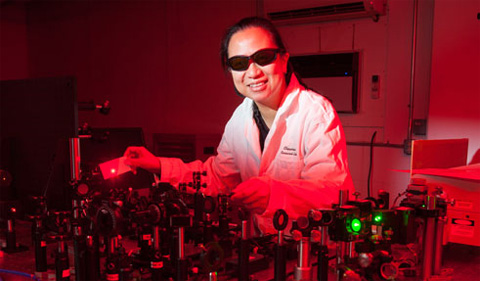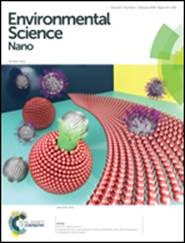
Dr. Katherine Cimatu in her lab in Clippinger Hall.
Adelaide Kruse and Dr. Katherine Cimatu contributed to an article “Engineered silica nanoparticles interact differently with lipid monolayers compared to lipid bilayers” that appeared on the cover of Environmental Science: Nano.
 Kruse is a Chemistry undergraduate student in the Honors Tutorial College, and Cimatu is Assistant Professor of Chemistry and Biochemistry at Ohio University. The other authors on the article are Ali Asghari Adib, Saeed Nazemidashtarjandi and Amir M. Farnoud of Russ College of Engineering at Ohio University and Alexander Kelly and Allan E. David of Auburn University.
Kruse is a Chemistry undergraduate student in the Honors Tutorial College, and Cimatu is Assistant Professor of Chemistry and Biochemistry at Ohio University. The other authors on the article are Ali Asghari Adib, Saeed Nazemidashtarjandi and Amir M. Farnoud of Russ College of Engineering at Ohio University and Alexander Kelly and Allan E. David of Auburn University.
The article, which is under consideration to be featured on the journal cover, focuses on the interaction of surface-modified silica nanoparticles with lipid monolayers and bilayers of the same composition (equimolar mixture of sphingomyelin, 1,2-dioleoyl-sn-glycero-3-phosphocholine, and cholesterol). The nanoparticles are functionalized with hydroxyl, amine, and polyethylene glycol (PEG, with molecular weights of 2K, 5K and 20K Daltons).
Kruse and Cimatu provided atomic force microscopy images to demonstrate the nanoparticle effects on the surface morphology of the supported bilayers. The AFM results indicated that the PEG-modified silica particles penetrated the monolayer and were subsequently squeezed out, while the hydroxyl- and amine-modified particles did not penetrate the monolayer.
Abstract: Despite a number of fundamental studies, the interactions of engineered nanoparticles with the cell plasma membrane are still not well understood. Membrane models, such as lipid monolayers and bilayers, have been used to provide a mechanistic understanding of nanoparticle effects on the structure and integrity of the cell membrane. However, the role of the membrane model itself in regulating nanoparticle–lipid interactions has generally been overlooked. In an effort to elucidate how changing the membrane model affects the resulting interactions with nanoparticles, the current study investigates the interaction of silica nanoparticles (104 ± 5 nm) with different surface-functional groups: plain (silanol), amine, and poly(ethylene glycol) (PEG), with various molecular weights of 2k, 5k, and 20k Daltons, with lipid monolayers and bilayers of the same composition. Studies with lipid monolayers demonstrated that PEGylated particles, regardless of the PEG molecular weight, and unlike plain and amine-modified particles, were able to penetrate the monolayer and disrupt the structure of lipids as evidenced by tensiometry and atomic force microscopy. In contrast, when interacting with lipid bilayers in suspension (i.e. vesicles), plain, amine-modified, and PEG 20k-modified particles disrupted vesicle structure, causing significant leakage, while PEG 2k- and 5k-modified particles did not affect the integrity of the vesicles. In summary, while the interactions of silica nanoparticles with membrane models is dependent on particle surface properties, a clear difference is observed in particle interactions with lipid monolayers compared to bilayers.



















Comments